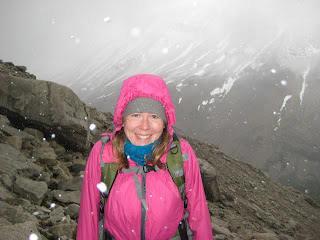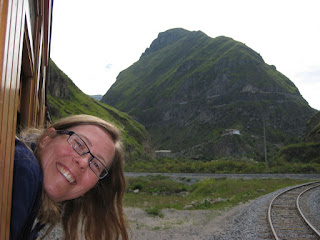 |
| Welcome indeed. |
Our plan is to do the W trek from west to east. We're lucky that Emma's sister did this a few weeks ago so again the route has been scouted and tips welcomed.
The first useful tip was being first off the boat and first to check in. This definitely saved at least 30 minutes of idle time, with people still on the boat some time later.
Due to sunlight hours closing in and our plan to do the trek in 4 days, we had resigned ourselves early to not having enough time to walk to the Grey Refuge and back, but with viewing points on the way of the impressive Grey Glacier, we set off to walk as far as we could.
Having started around 1pm, we walked for around 3hrs before turing round. We were close to the ideal turning point, but conscious of the light and not wanting to kill ourselves on day 1 we took the sensible, if disappointing, option and headed back.
On the walk itself we experienced what seemed like most possible weather conditions.
 |
| Parts of the Grey Glacier. |
Back at our base, mountain lodge Paine Grande, we had a canteen-style dinner and had an early night.
Distance covered ~20km
Wednesday 23rd March 2011
With a hearty breakfast in our stomachs, we set off at 8:15 to cover the middle section of the 'W'.
The first 2 hours was a really pleasant walk along to Camp Italiano in the middle. This was to be the easy part of the day. Early on we were overtaken at speed by a park ranger who made us feel very slow.
 |
| Avalanche! |
 |
| Amazing views. |
On the way back down, we experienced some of the stronger winds yet, nearly blowing us off the ridge as we struggled across.
Back at Bamp Italiano, we headed off along the lake. A lovely pebble beach along the way reminded us of the Galapagos, although it looked a little cold for snorkelling.
 |
| Cosy cabin. |
 |
| CENSORED |
Thursday 24th March 2011
 |
| The day's walk. |
The walk took us between mountains and lakes with the first 2 hrs in glorious sunshine. This was in total contrast to anything we'd exerienced before and to the last 2 hrs, where the normal wind and rain returned. It really is amazing how quickly the weather changes and we were happy to be prepared for all conditions.
We reached our next hostel around 2pm and settled in for a relaxing afternoon, conscious of the big walk awaiting us tomorrow.
The refugio is really nice, well run and set in lovely surroundings with a great view from every window. It felt less chaotic than yesterday's refugio but each place has had its own charm.
Distance covered 11km
Friday 25th March 2011
Today was the big one; the walk up to the mirador Torres to look at the central wonders of this park. Whilst not as long as day 2 in distance, this was certain to be the most uphill waking yet. We just hoped that our previous three day's walking and the altitude training in Ecuador would stand us in good stead.
It would have been ideal to get a good night's sleep in and by heading to bed at 9:30 for a 6:45 getup, we were hopeful. Between the noise of other people, a chap slipping over in the bathroom and some world- beating snoring, possibly by the same man who slipped, an early night was not possible. Luckily earplugs and the iPod came to the rescue.
We got breakfast at the earliest point and set off up the hill at 7.50. The moon was in the sky and some foxes were still foraging for food.
According to the map, the walk up to the viewpoint should take 4.5hrs, but we covered it in 3.5hrs taking plenty of breaks. We don't think we were fast and so we put it down to more erratic estimations of time, few of which can be trusted.
 |
| Refugio closed for winter. |
 |
| The misty Torres. |
 |
| Us at the Torres. |
 |
| Snow storm. |
 |
| Celebratory drinks. |
We arrived back in Puerto Natales just before 10 and had a bit of a result. We managed to get the last two seats on the bus to El Calafate the the next day at 7am. We checked in, grabbed our bags and found some accommodation for the next night. We headed off to sleep slightly apprehensive about our early start tomorrow.
Distance covered ~22km
General thoughts:
Camping vs Refugios: there are definitely pros and cons to both. If you want to do the 'W' trek, camping gives you far cheaper options for accommodation whilst also allowing you to split your days more evenly. On the other hand, you do have to carry your kit around and there's something nice about climbing into a bed at the end of a long day's walk. There's something for everyone here.
For us, lugging the amount of kit we've seen on people's backs would be a distraction from the views and beauty of the park. Car camping is still the way to go!
















































